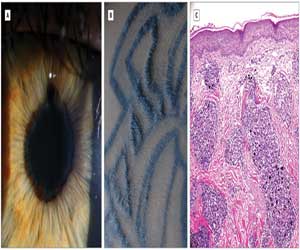- Home
- Editorial
- News
- Practice Guidelines
- Anesthesiology Guidelines
- Cancer Guidelines
- Cardiac Sciences Guidelines
- Critical Care Guidelines
- Dentistry Guidelines
- Dermatology Guidelines
- Diabetes and Endo Guidelines
- Diagnostics Guidelines
- ENT Guidelines
- Featured Practice Guidelines
- Gastroenterology Guidelines
- Geriatrics Guidelines
- Medicine Guidelines
- Nephrology Guidelines
- Neurosciences Guidelines
- Obs and Gynae Guidelines
- Ophthalmology Guidelines
- Orthopaedics Guidelines
- Paediatrics Guidelines
- Psychiatry Guidelines
- Pulmonology Guidelines
- Radiology Guidelines
- Surgery Guidelines
- Urology Guidelines
Case study of Tattoo-associated uveitis

Dr Kisha D. Piggott, at Saint Louis, MO.and colleagues have reported a case of Tattoo-associated uveitis that has appeared in JAMA clinical challenges.
Tattoo-associated uveitis was first described by Lubeck and Epstein in 1952, but to this day this rare ophthalmic complication remains incompletely understood. One of the earliest reports of tattoo-associated uveitis described patients with histologically confirmed tattoo granulomas and concurrent ocular inflammation. Tattoo-associated uveitis occurs 6 months to 10 years after tattoo placement. It has been suggested that the ocular manifestations represent a delayed hypersensitivity reaction to the tattoo ink.
According to history, a 26-year-old white man presented for evaluation of blurry vision over the past year. He had no back or joint pain or skin rashes. Five years ago he had a black ink tattoo placed on his left arm, and 3 years ago a second tattoo was placed on his right arm. Two years after the right arm tattoo was placed, he noticed tattoo elevation on the left arm and onset of decreased vision. He had recurrent episodes of ocular redness and blurred vision, coincident with inflammation of the skin surrounding both tattoos. Two months before presentation, bilateral peripheral iridotomies (iris laser procedures) were performed because of inflammation-induced adhesions between the iris and the lens.
At presentation, best corrected visual acuity was 20/20 in the right eye and 20/40 in the left. Intraocular pressure was 34 mm Hg in the right eye (upper limit of normal, 21 mm Hg) and 11 mm Hg in the left. On anterior segment slit lamp examination, there were no visible inflammatory cells in the anterior chamber of the right eye, but there were more than 26 cells per 1-mm field in the left. The left arm tattoo was elevated, with nodular elevation most prominent at the superior aspect of the tattoo. Punch biopsy of the tattooed skin revealed epithelioid histiocytes with macrophages containing coarse black granular pigment. Results of testing for syphilis, tuberculosis, and sarcoidosis were negative.
 A, Slitlamp photograph of left eye. B, Tattooed skin on left arm. C, Hematoxylin-eosin stain of skin biopsy sample (original magnification ×100).
A, Slitlamp photograph of left eye. B, Tattooed skin on left arm. C, Hematoxylin-eosin stain of skin biopsy sample (original magnification ×100).- Tattoo-associated uveitis is a rare, late sequela of tattooing that is not completely understood.
- Onset of uveitis typically occurs 6 months or more after tattooing.
- Tattoo ink may serve as an antigenic trigger for the development of granulomas in patients susceptible to sarcoidosis.
- Tattoo-associated uveitis may be associated with systemic sarcoidosis or may represent a delayed hypersensitivity reaction.
- Management options include local steroids, systemic prednisone, steroid-sparing agents such as methotrexate, azathioprine, or adalimumab, and excision of tattooed skin.
- Before initiating immunosuppressive therapy, however, common etiologies of uveitis, such as tuberculosis and syphilis, should be ruled out to avoid missing a diagnosis that could be exacerbated by steroid or other immune-compromising therapy.

Disclaimer: This site is primarily intended for healthcare professionals. Any content/information on this website does not replace the advice of medical and/or health professionals and should not be construed as medical/diagnostic advice/endorsement or prescription. Use of this site is subject to our terms of use, privacy policy, advertisement policy. © 2020 Minerva Medical Treatment Pvt Ltd